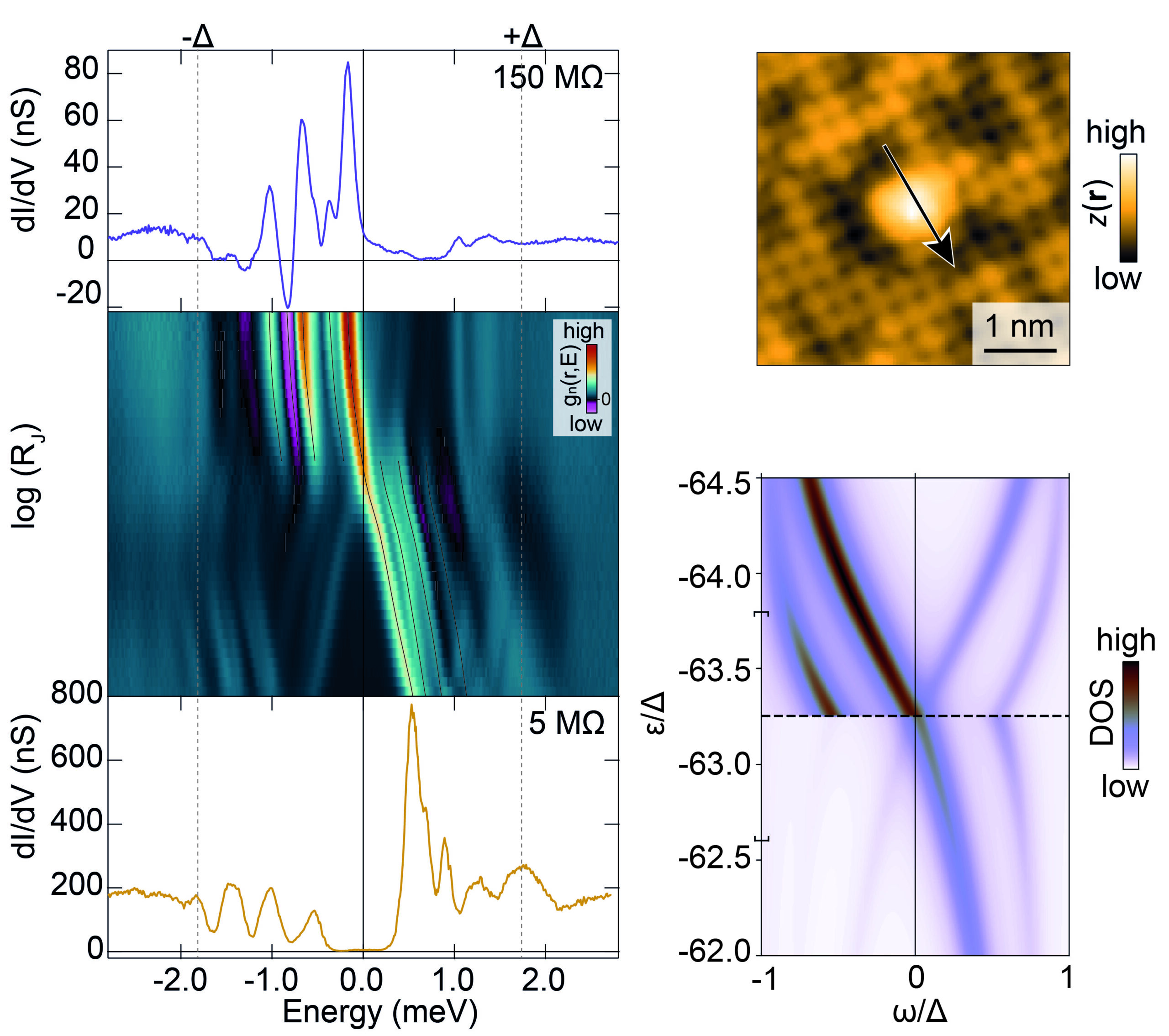| Sub-gap states generated by single spins in a superconductor can be used as building blocks for quantum devices. Physicists at the Laboratoire physique des solides (CNRS/Université Paris-Saclay) have uncovered that the sub-gap states of multi-spin impurities that are often used and are commonly considered as independent, are in fact intimately linked. Their findings reveal a complex interplay between the quantum states, leading to unanticipated changes in total spin and occupation. |

As soon as a state (a sharp peak of gn) crosses its position from negative to positive energy, all other peaks jump from negative to positive energy. The presence of negative values of gn also indicates strong quantum correlations between the multiple states on the impurity. The D is the superconducting gap. (Bottom right) Density of states of a correlated theoretical model, showing the simultaneous jump of intensities.
Material imperfections might be seen as an obstacle to achieving a desired quantum state. Yet, a different view has been developed for decades, namely, an impurity can be used as a tool: on the one hand, it can probe the quantum state of the underlying ideal material, and on the other hand, it may produce a different non-trivial quantum state in its vicinity. Historically, researchers at LPS Orsay have contributed significantly to the development of this point of view.
In the past decade, magnetic impurities in superconductors have experienced significant growth in popularity due to experimental breakthroughs. Advances in atomic-scale manipulation and improvements in Scanning Tunneling Microscopy (STM) techniques have transformed these impurities into probes for investigating potentially exotic and topological superconducting orders. The key motivation behind this work is the expectation that manipulating the magnetic impurities into bigger structures can create a new topological superconducting state in the underlying material that by itself is a basic trivial superconductor. Once the vicinity of the impurities becomes topological, the electrons form new types of collective excitations, such as Majorana zero modes, that have been highly sought-for excitations able to perform topological quantum computation.
Intriguingly, most of the theory developed to complement these advances with great success has been based on one simplified assumption introduced more than 50 years ago: that the magnetic impurity can be treated as a classical object, a small magnet with fixed orientation. The electrons in the superconductor attach to a classical magnet to form possibly multiple independent Yu-Shiba-Russinov (YSR) excitations, that seem a very efficient description of all STM observations, and a sufficient description of an excitation that can create a collective Majorana zero mode when these classical impurities are engineered into favorable positions. This “unreasonable effectiveness” of a simple classical modeling of the magnetic impurity could almost be regarded as a failure of our understanding, since experimental signatures of the deeper quantum effects of the impurity within the quantum superconducting system, were very scarce.
In this work, researchers at LPS have revealed that a single iron impurity in an iron-based superconductor generates multiple excitations that are strikingly correlated, requiring a fully quantum description beyond the conventional YSR framework.
The experiment at LPS involved an STM tip, whose distance from the impurity was varied in a controlled way with high precision, while it was measuring the electronic excitations at the impurity. The first key observation was that as one excitation crosses zero energy, signaling a change in the quantum state underlying it, all other excitations immediately do so too, invalidating the assumption of independence of excitations (see Figure1b). The second key observation was that for some experimental parameters, the increase of voltage between the tip and the impurity led to a decrease in the current flowing between them, an effect that is only explainable by quantum interference effects on the impurity, invalidating the assumption of it being a classical magnet.
The researchers at LPS built an appropriate minimal theoretical model to capture both these observations, providing an interpretation that the impurity has multiple quantum states that are interacting, and so multiple electrons from the superconductor tend to occupy them in a correlated and entangled way as they are excited, invalidating any classical description.
This work poses a new conceptual challenge to the field, as it points to the necessity of developing further the understanding of quantum interacting impurities, certainly when they appear in superconductors. Remarkably, the experiment has revealed the new phenomenology systematically on multiple impurities positioned in the studied area of the material. Additionally, iron atoms are the typical magnetic impurities used in experiments on various materials. This makes it clear that the quantum description of interacting magnetic impurities is an urgent prerequisite to any engineering of collective excitations for topological quantum computing.
The findings and additional discussions have recently been published in Nature Communications.
Contributors
Team Nanosecond at the Nanoscale (NS2)
Team Theorie
Brookhaven National Laboratory, USA
Fundings
ANR (ANR-22-CE30-0037, ANR-21-CE30-0017-01), US Department of Energy, office of Basic Energy Sciences, contract no. DOE-sc0012704
References
M. Uldemolins, A. Mesaros, G. D. Gu, A. Palacio-Morales, M. Aprili, P. Simon and F. Massee
Nature Communications 15, 8526 (2024)
doi : 10.1038/s41467-024-52847-9
Contacts
Freek Massee – freek.massee@universite-paris-saclay.fr
